Page 324 of 424
Windshield Washers
The fluid reservoir for the windshield washers and the
rear window washer is shared. It is located in the front of
the engine compartment on the passenger side and
should be checked for fluid level at regular intervals. Fillthe reservoir with windshield washer solvent (not
antifreeze/coolant) and operate the system for a few
seconds to flush out the residual water.
WARNING!
Commercial windshield washer solvents are flam-
mable. They could ignite and burn you. Care must
be exercised when filling or working around the
washer solution.
Exhaust System
The best protection against carbon monoxide entry into
the vehicle body is a properly maintained engine exhaust
system.
If you notice a change in the sound of the exhaust system;
or if the exhaust fumes can be detected inside the vehicle;
or when the underside or rear of the vehicle is damaged;
324 MAINTAINING YOUR VEHICLE
Page 325 of 424

have an authorized technician inspect the complete ex-
haust system and adjacent body areas for broken, dam-
aged, deteriorated, or mispositioned parts. Open seams
or loose connections could permit exhaust fumes to seep
into the passenger compartment. In addition, inspect the
exhaust system each time the vehicle is raised for lubri-
cation or oil change. Replace as required.
Cooling System
WARNING!
You or others can be badly burned by hot antifreeze/
coolant or steam from your radiator. If you see or
hear steam coming from under the hood, don’t open
the hood until the radiator has had time to cool.
Never try to open a cooling system pressure cap
when the radiator or coolant bottle is hot.
Engine Coolant Checks
Check antifreeze/coolant protection every 12 months
(before the onset of freezing weather, where applicable).
If antifreeze/coolant is dirty or rusty in appearance, the
system should be drained, flushed and refilled with fresh
antifreeze/coolant. Check the front of the A/C condenser
(if equipped) or radiator for any accumulation of bugs,
leaves, etc. If dirty, clean by gently spraying water from a
garden hose vertically down the face of the A/C con-
denser (if equipped) or the radiator core.
Check the engine cooling system hoses for brittle rubber,
cracking, tears, cuts, and tightness of connection at the
coolant recovery bottle and radiator. Inspect the entire
system for leaks.
MAINTAINING YOUR VEHICLE 325
7
Page 328 of 424
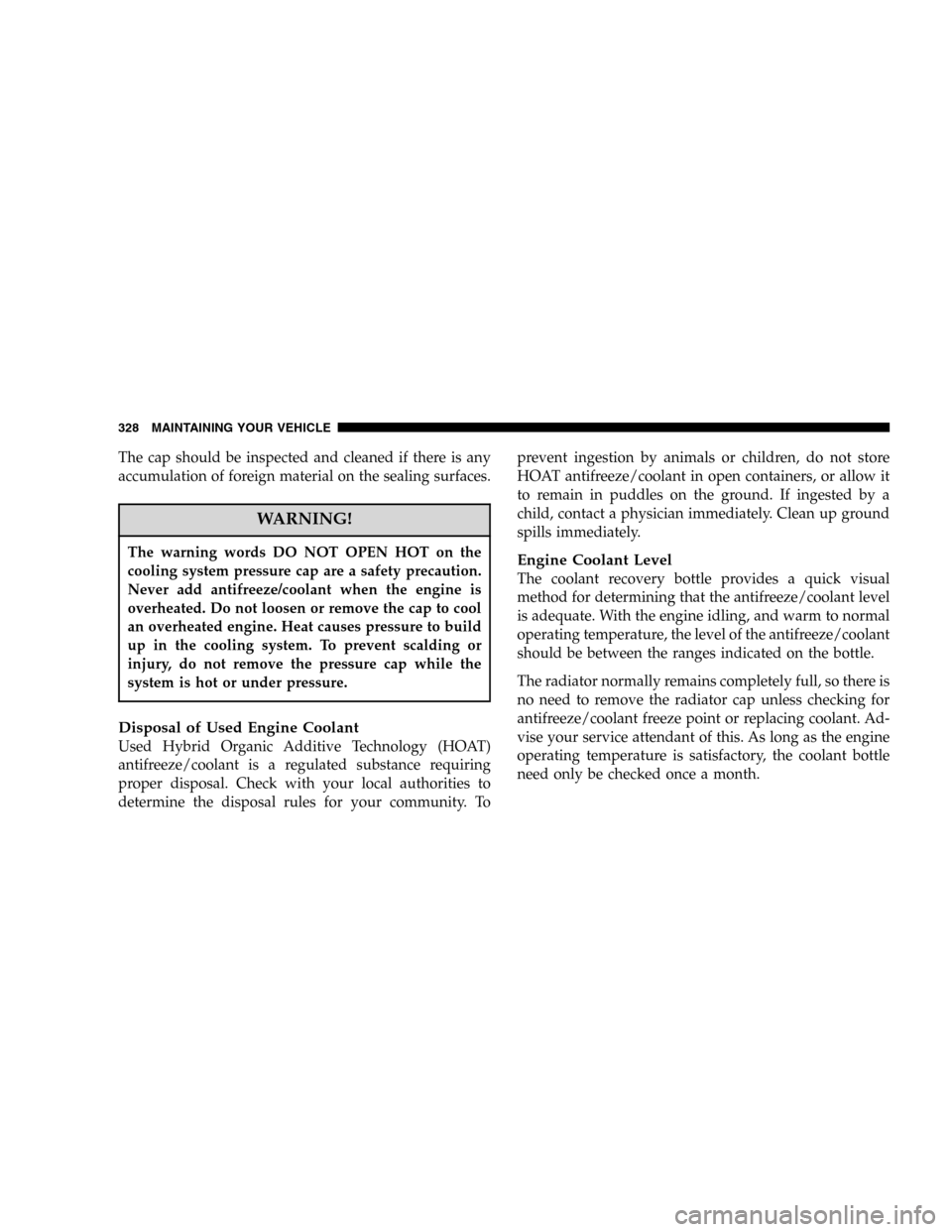
The cap should be inspected and cleaned if there is any
accumulation of foreign material on the sealing surfaces.
WARNING!
The warning words DO NOT OPEN HOT on the
cooling system pressure cap are a safety precaution.
Never add antifreeze/coolant when the engine is
overheated. Do not loosen or remove the cap to cool
an overheated engine. Heat causes pressure to build
up in the cooling system. To prevent scalding or
injury, do not remove the pressure cap while the
system is hot or under pressure.
Disposal of Used Engine Coolant
Used Hybrid Organic Additive Technology (HOAT)
antifreeze/coolant is a regulated substance requiring
proper disposal. Check with your local authorities to
determine the disposal rules for your community. Toprevent ingestion by animals or children, do not store
HOAT antifreeze/coolant in open containers, or allow it
to remain in puddles on the ground. If ingested by a
child, contact a physician immediately. Clean up ground
spills immediately.
Engine Coolant Level
The coolant recovery bottle provides a quick visual
method for determining that the antifreeze/coolant level
is adequate. With the engine idling, and warm to normal
operating temperature, the level of the antifreeze/coolant
should be between the ranges indicated on the bottle.
The radiator normally remains completely full, so there is
no need to remove the radiator cap unless checking for
antifreeze/coolant freeze point or replacing coolant. Ad-
vise your service attendant of this. As long as the engine
operating temperature is satisfactory, the coolant bottle
need only be checked once a month.
328 MAINTAINING YOUR VEHICLE
Page 331 of 424
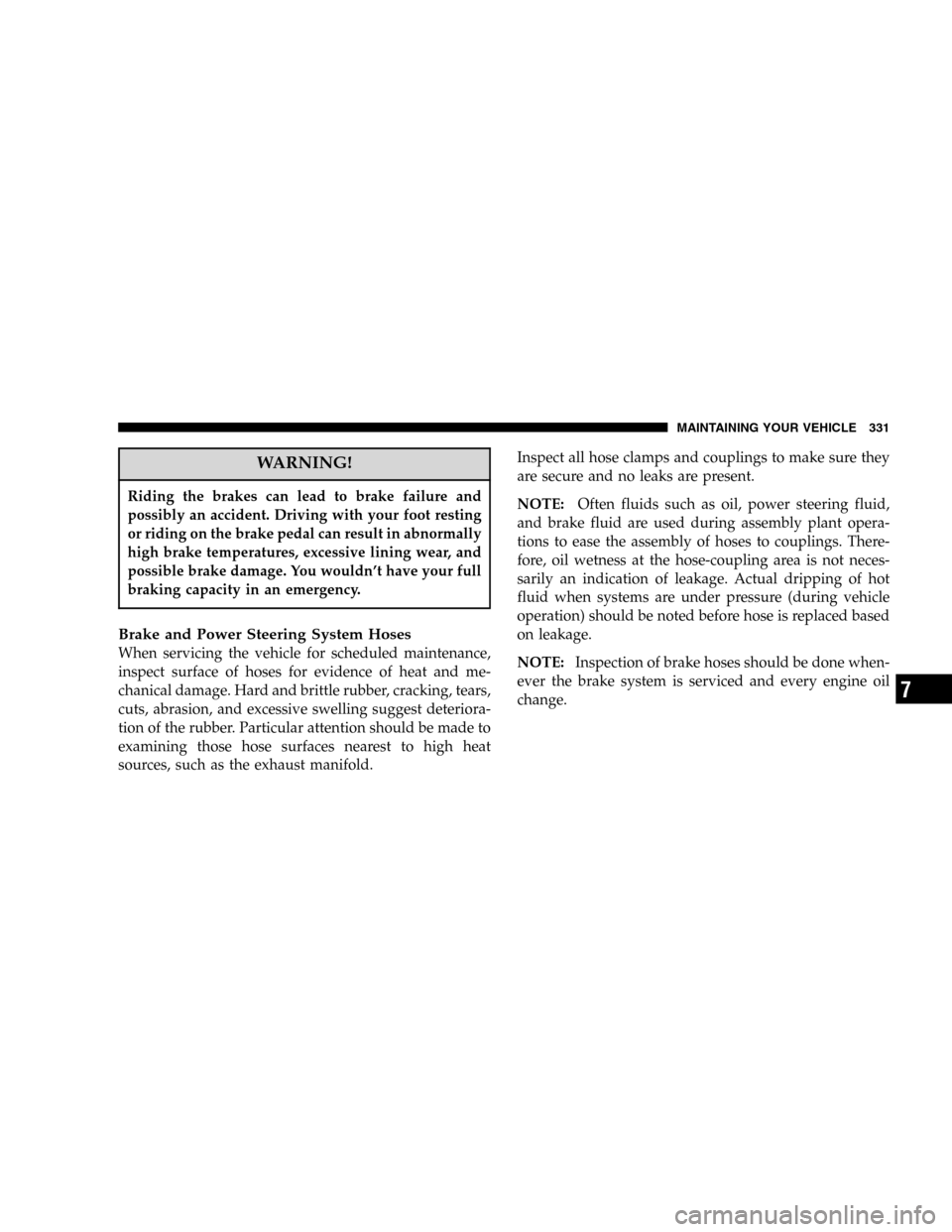
WARNING!
Riding the brakes can lead to brake failure and
possibly an accident. Driving with your foot resting
or riding on the brake pedal can result in abnormally
high brake temperatures, excessive lining wear, and
possible brake damage. You wouldn’t have your full
braking capacity in an emergency.
Brake and Power Steering System Hoses
When servicing the vehicle for scheduled maintenance,
inspect surface of hoses for evidence of heat and me-
chanical damage. Hard and brittle rubber, cracking, tears,
cuts, abrasion, and excessive swelling suggest deteriora-
tion of the rubber. Particular attention should be made to
examining those hose surfaces nearest to high heat
sources, such as the exhaust manifold.Inspect all hose clamps and couplings to make sure they
are secure and no leaks are present.
NOTE:Often fluids such as oil, power steering fluid,
and brake fluid are used during assembly plant opera-
tions to ease the assembly of hoses to couplings. There-
fore, oil wetness at the hose-coupling area is not neces-
sarily an indication of leakage. Actual dripping of hot
fluid when systems are under pressure (during vehicle
operation) should be noted before hose is replaced based
on leakage.
NOTE:Inspection of brake hoses should be done when-
ever the brake system is serviced and every engine oil
change.
MAINTAINING YOUR VEHICLE 331
7
Page 332 of 424
WARNING!
Worn brake hoses can burst and cause brake failure.
You could have an accident. If you see any signs of
cracking, scuffing, or worn spots, have the brake
hoses replaced immediately.
Brake Master Cylinder
The fluid level in the master cylinder should be checked
when performing under hood services, or immediately if
the “Brake Warning Light” shows system failure.
Be sure to clean the top of the master cylinder area before
removing the cap. If necessary, add fluid to bring the
fluid level up to the requirements described on the brake
fluid reservoir. With disc brakes, fluid level can be
expected to fall as the brake pads wear. However, low
fluid level may be caused by a leak and a checkup may be
needed.
332 MAINTAINING YOUR VEHICLE
Page 333 of 424
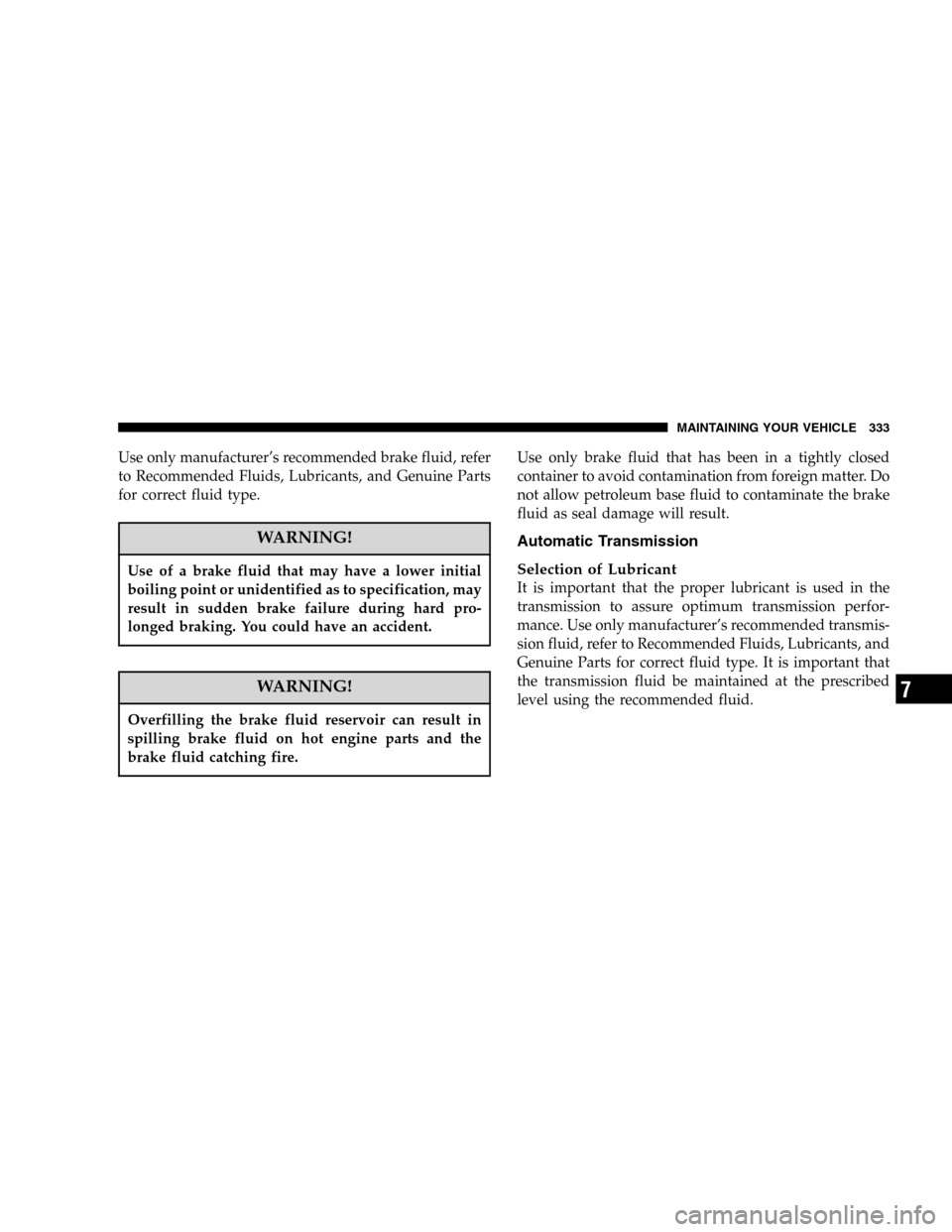
Use only manufacturer’s recommended brake fluid, refer
to Recommended Fluids, Lubricants, and Genuine Parts
for correct fluid type.
WARNING!
Use of a brake fluid that may have a lower initial
boiling point or unidentified as to specification, may
result in sudden brake failure during hard pro-
longed braking. You could have an accident.
WARNING!
Overfilling the brake fluid reservoir can result in
spilling brake fluid on hot engine parts and the
brake fluid catching fire.
Use only brake fluid that has been in a tightly closed
container to avoid contamination from foreign matter. Do
not allow petroleum base fluid to contaminate the brake
fluid as seal damage will result.
Automatic Transmission
Selection of Lubricant
It is important that the proper lubricant is used in the
transmission to assure optimum transmission perfor-
mance. Use only manufacturer’s recommended transmis-
sion fluid, refer to Recommended Fluids, Lubricants, and
Genuine Parts for correct fluid type. It is important that
the transmission fluid be maintained at the prescribed
level using the recommended fluid.
MAINTAINING YOUR VEHICLE 333
7
Page 340 of 424
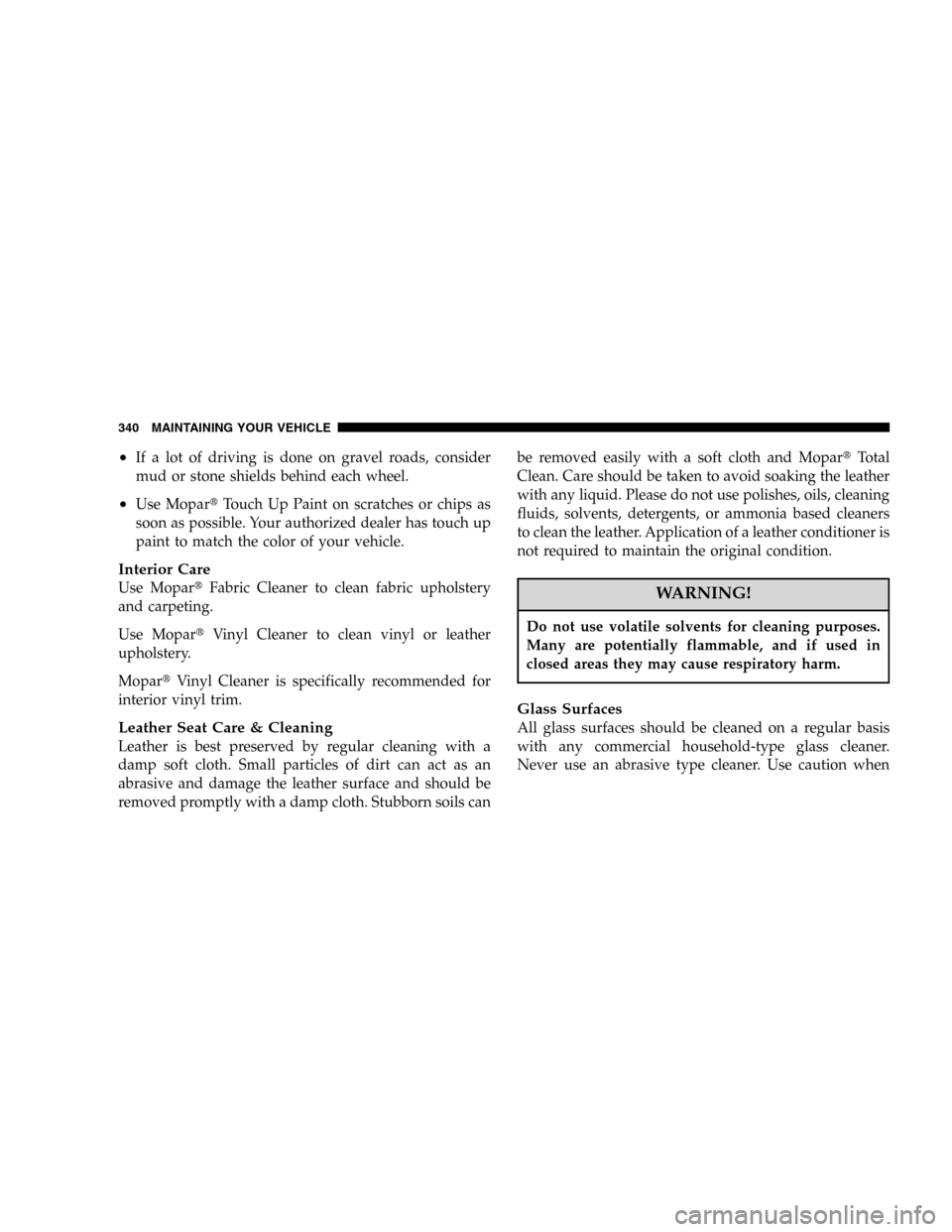
•If a lot of driving is done on gravel roads, consider
mud or stone shields behind each wheel.
•Use Mopar�Touch Up Paint on scratches or chips as
soon as possible. Your authorized dealer has touch up
paint to match the color of your vehicle.
Interior Care
Use Mopar�Fabric Cleaner to clean fabric upholstery
and carpeting.
Use Mopar�Vinyl Cleaner to clean vinyl or leather
upholstery.
Mopar�Vinyl Cleaner is specifically recommended for
interior vinyl trim.
Leather Seat Care & Cleaning
Leather is best preserved by regular cleaning with a
damp soft cloth. Small particles of dirt can act as an
abrasive and damage the leather surface and should be
removed promptly with a damp cloth. Stubborn soils canbe removed easily with a soft cloth and Mopar�Total
Clean. Care should be taken to avoid soaking the leather
with any liquid. Please do not use polishes, oils, cleaning
fluids, solvents, detergents, or ammonia based cleaners
to clean the leather. Application of a leather conditioner is
not required to maintain the original condition.
WARNING!
Do not use volatile solvents for cleaning purposes.
Many are potentially flammable, and if used in
closed areas they may cause respiratory harm.
Glass Surfaces
All glass surfaces should be cleaned on a regular basis
with any commercial household-type glass cleaner.
Never use an abrasive type cleaner. Use caution when
340 MAINTAINING YOUR VEHICLE
Page 400 of 424
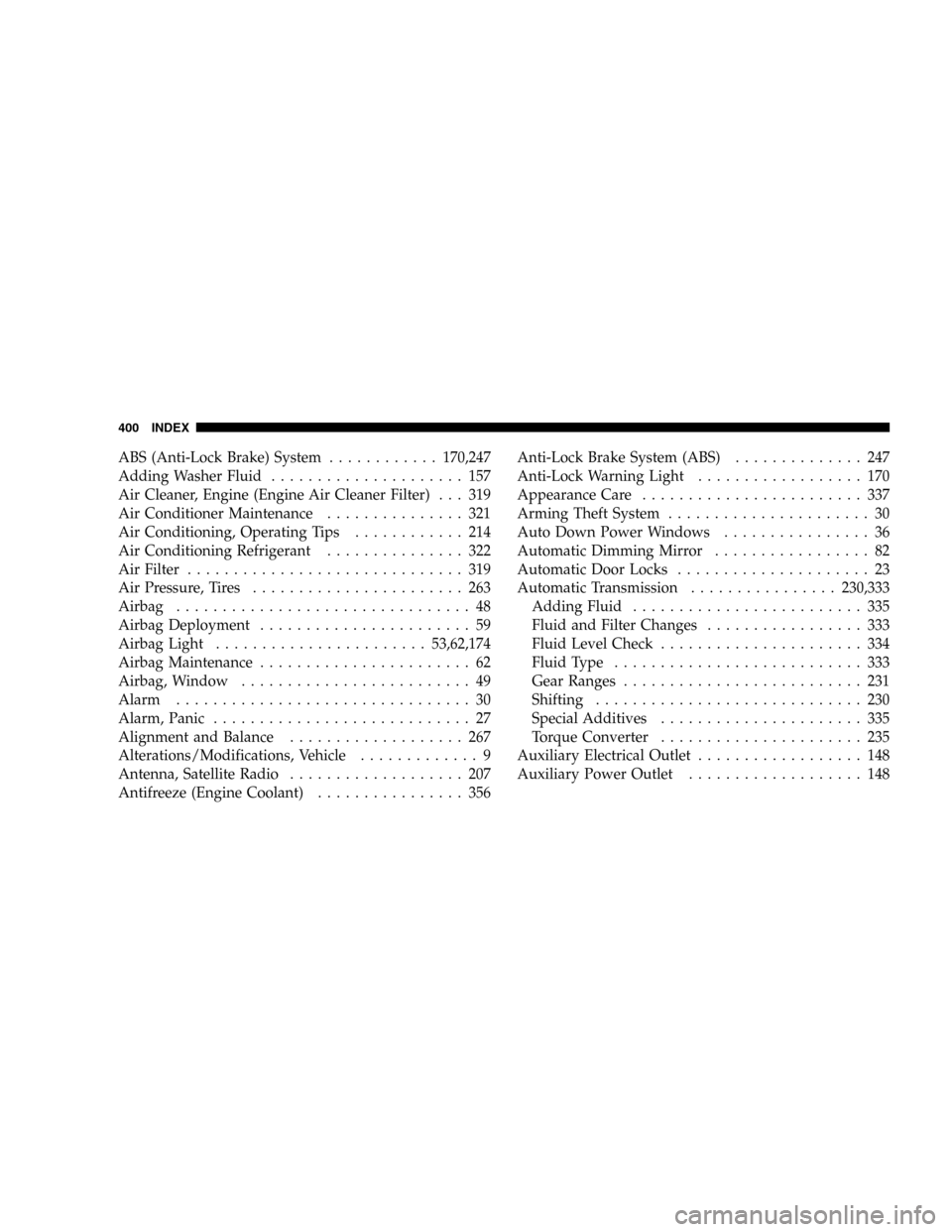
ABS (Anti-Lock Brake) System............170,247
Adding Washer Fluid..................... 157
Air Cleaner, Engine (Engine Air Cleaner Filter) . . . 319
Air Conditioner Maintenance............... 321
Air Conditioning, Operating Tips............ 214
Air Conditioning Refrigerant............... 322
Air Filter.............................. 319
Air Pressure, Tires....................... 263
Airbag................................ 48
Airbag Deployment....................... 59
Airbag Light.......................53,62,174
Airbag Maintenance....................... 62
Airbag, Window......................... 49
Alarm................................ 30
Alarm, Panic............................ 27
Alignment and Balance................... 267
Alterations/Modifications, Vehicle............. 9
Antenna, Satellite Radio................... 207
Antifreeze (Engine Coolant)................ 356Anti-Lock Brake System (ABS).............. 247
Anti-Lock Warning Light.................. 170
Appearance Care........................ 337
Arming Theft System...................... 30
Auto Down Power Windows................ 36
Automatic Dimming Mirror................. 82
Automatic Door Locks..................... 23
Automatic Transmission................230,333
Adding Fluid......................... 335
Fluid and Filter Changes................. 333
Fluid Level Check...................... 334
Fluid Type........................... 333
Gear Ranges.......................... 231
Shifting............................. 230
Special Additives...................... 335
Torque Converter...................... 235
Auxiliary Electrical Outlet.................. 148
Auxiliary Power Outlet................... 148
400 INDEX